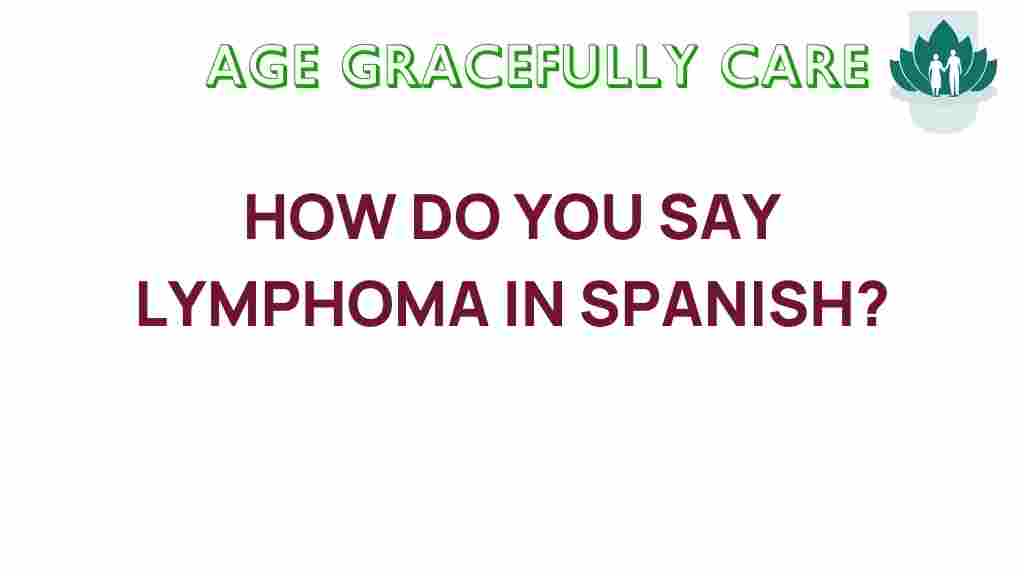Unraveling the Mystery: How Do You Say Lymphoma in Spanish?
Lymphoma is a type of cancer that affects the lymphatic system, an integral part of the body’s immune system. As cancer awareness continues to grow, so does the need for effective communication regarding health issues across different languages. Understanding medical terminology in various languages, particularly for conditions like lymphoma, can bridge gaps in health literacy and enhance patient education. In this article, we will explore how to say lymphoma in Spanish, delve into medical terminology, and discuss the importance of bilingualism in health communication.
Understanding Lymphoma
Before we translate the term, it is essential to understand what lymphoma entails. Lymphoma is categorized into two main types: Hodgkin lymphoma and non-Hodgkin lymphoma. Both types involve the uncontrolled growth of lymphocytes, a type of white blood cell crucial for the immune response.
- Hodgkin Lymphoma: Characterized by the presence of Reed-Sternberg cells.
- Non-Hodgkin Lymphoma: A diverse group of blood cancers that includes various subtypes.
Symptoms of lymphoma may include swollen lymph nodes, fever, night sweats, and unexplained weight loss. Early diagnosis and treatment are critical for improving outcomes.
How Do You Say Lymphoma in Spanish?
The Spanish translation of lymphoma is linfoma. This term is used universally across Spanish-speaking countries, making it a crucial part of medical vocabulary for healthcare professionals, patients, and caregivers alike.
The Importance of Medical Terminology in Bilingualism
For effective communication in healthcare, understanding medical terminology in both English and Spanish is vital. Bilingualism enhances health literacy, allowing patients to better comprehend their conditions and treatment options. Here are a few reasons why this is important:
- Improved Patient Understanding: Patients who understand their diagnosis are more likely to adhere to treatment plans.
- Enhanced Communication: Bilingual healthcare providers can better serve diverse populations.
- Increased Awareness: Knowledge of medical terms in multiple languages can lead to greater awareness about health issues like lymphoma.
Learning Medical Spanish
For healthcare professionals and language learners alike, acquiring medical Spanish vocabulary is beneficial. Here are some practical steps to enhance your medical Spanish proficiency:
- Enroll in Medical Spanish Courses: Many institutions offer courses tailored for healthcare professionals.
- Utilize Online Resources: Websites and apps can provide vocabulary lists and practice exercises.
- Engage with Spanish-speaking Communities: Practice speaking with native speakers to gain confidence and fluency.
Steps for Effective Communication with Spanish-speaking Patients
Communicating effectively with Spanish-speaking patients involves more than just knowing the translation of medical terms. Here’s a step-by-step process to ensure clarity and understanding:
Step 1: Use Simple Language
Avoid jargon and complicated medical terms unless necessary. Use simple language and explain complex concepts in understandable terms.
Step 2: Confirm Understanding
After explaining a diagnosis like lymphoma, ask the patient to summarize what they have understood. This can help identify any areas that need clarification.
Step 3: Provide Written Materials in Spanish
Supplement verbal communication with written materials that are translated into Spanish. This can include brochures, consent forms, and educational pamphlets.
Step 4: Utilize Visual Aids
Visual aids can enhance understanding. Diagrams, charts, and images can help explain medical conditions and treatments effectively.
Troubleshooting Common Communication Barriers
Despite best efforts, communication barriers may still arise. Here are some troubleshooting tips for common issues:
- Misunderstandings: If a patient seems confused, rephrase your explanation or use different examples.
- Cultural Differences: Be aware of cultural nuances that may affect health perceptions. Respect cultural beliefs regarding illness and treatment.
- Limited Vocabulary: If you encounter words that are difficult to translate, use simpler synonyms or describe the concept in different terms.
Conclusion: The Path to Enhanced Health Literacy
Understanding how to say lymphoma in Spanish—linfoma—is just the beginning of fostering effective communication in healthcare settings. By embracing bilingualism and enhancing medical terminology comprehension, we can significantly improve health literacy among diverse populations. This not only empowers patients but also strengthens the overall healthcare experience.
As we continue to advocate for cancer awareness and patient education, let us remember the crucial role language plays in these efforts. For more information on lymphoma and resources for Spanish-speaking patients, visit Cancer.org.
To further enhance your medical Spanish skills, consider exploring courses and resources available at MedSpanish.com.
In conclusion, effective communication in healthcare settings is a vital component of patient care. By recognizing and overcoming language barriers, we can ensure that all patients receive the education and support they need to navigate their health journeys, particularly when facing conditions like lymphoma.
This article is in the category Health and created by AgeGracefullyCare Team
